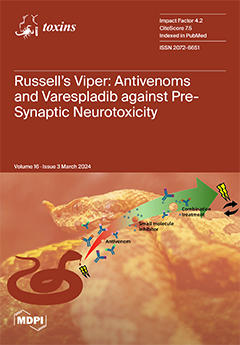Toad Venom (TV) is the dried product of toxic secretions from
Bufo bufo gargarizans Cantor (BgC) or
B. melanostictus Schneider (BmS). Given the increasing medical demand and the severe depletion of wild toads, a number of counterfeit TVs appeared on the market, posing challenges
[...] Read more.
Toad Venom (TV) is the dried product of toxic secretions from
Bufo bufo gargarizans Cantor (BgC) or
B. melanostictus Schneider (BmS). Given the increasing medical demand and the severe depletion of wild toads, a number of counterfeit TVs appeared on the market, posing challenges to its quality control. In order to develop an efficient, feasible, and comprehensive approach to evaluate TV quality, a thorough analysis and comparison of chemical compounds among legal species BgC and BmS, as well as the main confusion species
B. andrewsi Schmidt (BaS) and
B. raddei Strauch (BrS), were conducted by ultra-performance liquid chromatography–quadrupole time-of-flight mass spectrometry (UPLC-Q-TOF/MS), high performance liquid chromatography (HPLC), sodium dodecylsulfate-polyacrylamide gel electrophoresis (SDS-PAGE), and Nano LC-MS/MS analyses. We identified 126 compounds, including free or conjugated bufadienolides, indole alkaloids and amino acids, among the four
Bufo species. The content of main bufadienolides, such as gamabufotalin, bufotalin, bufalin, cinobufagin, and resibufogenin, and the total protein contents varied widely among 28 batches of TV due to their origin species. The sum of the five bufadienolides within the BgC, BmS, BaS, and BrS samples were 8.15–15.93%, 2.45–4.14%, 11.15–13.50%, and 13.21–14.68%, respectively. The total protein content of BgC (6.9–24.4%) and BaS (19.1–20.6%) samples were higher than that of BmS (4.8–20.4%) and BrS (10.1–13.7%) samples. Additionally, a total of 1357 proteins were identified. There were differences between the protein compositions among the samples of the four
Bufo species. The results indicated that BgC TV is of the highest quality; BaS and BrS TV could serve as alternative resources, whereas BmS TV performed poorly overall. This research provides evidence for developing approaches to evaluate TV quality and selecting the proper
Bufo species as the origin source of TV listed in the Chinese pharmacopoeia.
Full article






